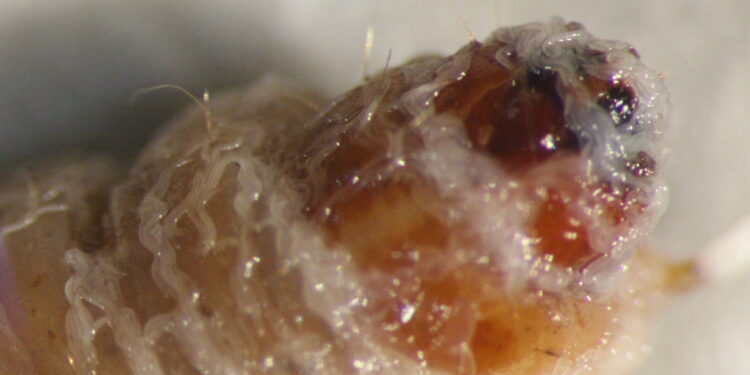Steinernema adamsi being released from the body of a deceased host. Credit: Adler Dillman/UCR
UC Riverside scientists have discovered a tiny species of worm that infects and kills insects. These worms, called nematodes, could combat crop pests in warm, humid locations where other beneficial nematodes are currently unable to thrive.
This new species is part of a family of nematodes called Steinernema that have long been used in agriculture to control parasitic insects without pesticides. Steinernema are not harmful to humans or other mammals and were first discovered in the 1920s.
“We spray billions of them on crops every year, and they’re easy to buy,” said Adler Dillman, a professor of nematology at UCR whose lab made the discovery. “Although there are more than 100 species of Steinernema, we are always looking for new ones because each has unique characteristics. Some might be better in certain climates or with certain insects.”
Hoping to better understand another Steinernema species, Dillman’s lab requested samples from colleagues in Thailand. “We did DNA analysis of the samples and realized they were not what we had asked for. Genetically, they were unlike anything else that had ever been described,” Dillman said.
Dillman and his colleagues have now described the new species in the Journal of Parasitology. They are almost invisible to the naked eye, about half the width of a human hair, and just under a millimeter long. “Several thousand in a bottle looks like dusty water,” Dillman said.
They named the new species Steinernema adamsi in honor of American biologist Byron Adams, chair of the biology department at Brigham Young University.
“Adams helped refine our understanding of nematode species and their important role in ecology and nutrient recycling in the soil,” Dillman said. “He was also my undergraduate advisor and the person who introduced me to nematodes. It seemed a very fitting tribute.”
Adams, who is currently conducting research on nematodes in Antarctica, said he was honored to have such a “cool” species named after him in the scientific literature.
“The biology of this animal is absolutely fascinating,” Adams said. “Besides its obvious applications in alleviating human suffering caused by insect pests, it also has much to teach us about the ecological and evolutionary processes involved in the complex negotiations that take place between parasites, pathogens, their hosts and their microbiomes environmental.”
Learning about the life cycle of these worms as an undergraduate is what got Dillman interested in studying them. As juveniles, nematodes live in the soil with their mouths closed, in a state of arrested development. At this point, they roam the ground looking for insects to infect. Once they find a victim, they enter the mouth or anus and defecate highly pathogenic bacteria.
“A parasite that expels disease-causing substances to help kill its host, that’s unusual to begin with,” Dillman said. “It’s like something out of a James Cameron movie.”
Within 48 hours of infection, the insect dies. “Essentially, it liquefies the insect, and then you’re left with a sac that was once its body. You can have 10 or 15 nematodes in a host, and 10 days later you have 80,000 new individuals in the soil at the looking for new insects to infect,” Dillman said.
Researchers are certain that S. adamsi kills insects. They confirmed this by placing some of them in containers containing wax moths. “It killed the butterflies in two days with a very low dose of worms,” Dillman said.
In the future, researchers hope to discover the unique properties of the nematode. “We don’t yet know if it can withstand heat, UV rays or drought. And we don’t yet know the extent of insects it is capable of infecting.
However, S. adamsi is part of a genus that can infect hundreds of types of insects. Therefore, researchers are confident that it will be beneficial on some level whether it is a specialist or a generalist parasite of several types of insects.
“This is exciting because this discovery adds another insect killer that could teach us new and interesting biology,” Dillman said. “Also, they come from a warm, humid climate, which could make them a good insect parasite in environments where currently commercially available orchard nematodes have not been able to thrive.”
More information:
Journal of Parasitology (2024). DOI: 10.1645/23-60
Provided by University of California – Riverside
Quote: Discovery of new species of nematodes capable of protecting crops without pesticides (February 8, 2024) retrieved February 8, 2024 from
This document is subject to copyright. Apart from fair use for private study or research purposes, no part may be reproduced without written permission. The content is provided for information only.



